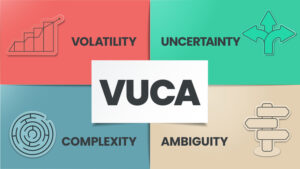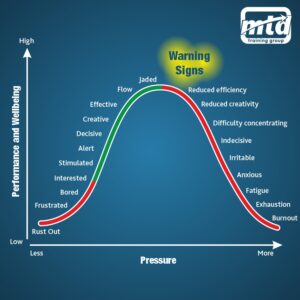The Crucial Transition from Individual Contributor to Manager in Today’s VUCA World
In the first and second posts of this series we reviewed facts and trends for new cybersecurity leaders and then considered what a path to success would look like based on what executives are looking for in their leaders. The need for analytical skills, communications skills, critical thinking and creativity means the CISO has an expanding role – one who not only is a tech leader but also works with colleagues in the C-Suite.
This article’s provocative title, “Managers Don’t Cry,” underscores the intense pressure new front-line managers face, particularly those transitioning from technical expertise to managerial roles. This shift often leaves them without the necessary skills or training, thrusting them into a realm where their technical expertise no longer suffices. Moreover, these managers frequently find themselves in an environment lacking psychological safety, where expressing insecurities or concerns about their new managerial challenges is not welcomed. This scenario forces them to show apparent resilience in the face of unfamiliar responsibilities and the expectation to perform without showing vulnerability.
In an era of rapid change and unpredictability, the role of managers in Fortune 500 companies is more challenging than ever. Leadership development has become pivotal in guiding these organizations through the tumultuous business landscape.

Understanding the VUCA Environment
The VUCA world – Volatile, Uncertain, Complex, and Ambiguous – has become the new norm. Managers must navigate through these challenges, often without adequate training or preparation. Research shows that 44% of managers feel overwhelmed at work, a clear indicator of the stress and uncertainty in their roles. Additionally, 59% of employees lack the mastery of skills needed for their jobs, exacerbating the challenge for managers who must lead these underprepared teams.
The Transformation from Contributor to Manager
The journey from being an individual contributor to a manager is a profound career change, marked by a shift in responsibilities and required skill sets. Many organizations, recognizing the importance of this transition, are investing in manager development programs. These programs aim to equip managers with the skills to navigate challenges and lead their teams effectively.

Breaking the Cycle of Stress and Turnover
Stress, often stemming from increased responsibilities and limited resources, has become a significant issue, contributing to high turnover rates. According to Zippia’s workplace stress statistics, U.S. businesses lose up to $300 billion yearly due to workplace stress. Furthermore, CareerAddict highlights that poor management is a major reason employees quit their jobs. This turnover affects employee morale and creates a cycle where untrained managers lead to poor leadership and further turnover.
Key Elements of a Successful Manager Development Program
- Understanding VUCA: Training must include modules on leading in a VUCA world, focusing on handling volatility, uncertainty, complexity, and ambiguity.
- Managing Transformational Change: Programs should address the emotional stages of change and how to navigate them effectively.
- Building Resilience: Developing a mindset of resilience is crucial for managers to adapt and thrive in changing circumstances.
Going through a training program is not enough, as this McKinsey case study demonstrates.
Case Study: Leadership Development in a High-Growth Organization
A case study presented by McKinsey of a large Asian infrastructure conglomerate, shows the impact of effective leadership development. Facing a leadership shortage, the company implemented a multi-year program focusing on emerging leaders, entrepreneurial leadership, and integrating leadership development into their culture. This approach, including personal mastery, forums, breakthrough projects, coaching, and a development council, significantly improved their leadership capabilities, aligning with the company’s growth objectives.
The Harvard Business Review article “The Future of Leadership Development” emphasizes the evolving nature of leadership training. In today’s dynamic business environment, traditional approaches to leadership development are becoming obsolete. The article suggests a more personalized, agile, and tech-driven approach to training that aligns with the modern business landscape. This new paradigm involves integrating real-world projects into learning, leveraging technology for custom learning experiences, and focusing on developing crucial skills in a volatile, uncertain, complex, and ambiguous (VUCA) world.
Conclusion
A shift in leadership development is urgently needed, particularly for those transitioning from technical roles to managerial positions. The VUCA world demands a new breed of managers – resilient, adaptable, and skilled in handling transformational change. By focusing on managing self, teams, and across the enterprise, companies can prepare their leaders to face the challenges of modern business dynamics. Modern development programs must be agile, personalized, and equipped with strategies to foster resilience and adaptability. As demonstrated in the McKinsey case study, organizations that invest in such comprehensive and progressive leadership development are better positioned to navigate the complexities of today’s business environment, enhancing their managerial cadre and their organization’s overall health and success.
We will cover options for cybersecurity leadership to update their mindset in future posts.
A suggested path, that combines training, executive coaching and group discussions, is ORCA’s Manager Academy. We gave a complete overview of this program in a previous post here.
Additional Information
- New Manager Preparedness
- Guiding Cybersecurity from the Boardroom Publisher: TAG Cyber, a division of TAG Infosphere, Inc., 45 Broadway, Suite 1250, New York, NY 10006. Copyright © 2023 by TAG Infosphere, Inc. All rights reserved. This publication may be freely reproduced, freely quoted, freely distributed, or freely transmitted in any form or by any means, electronic or mechanical, including photocopying, recording, or any information storage and retrieval system without need to request permission from the publisher, so long as the content is neither changed nor attributed to a different source.
- NACD: 2023 Director’s Handbook on Cyber-Risk Oversight
Resources:
- Click here for more on From Problem Solving to Solution Design
- Click here for a free chapter from the book.
- Are you offering solutions that matter? Click here for a free Solution Design assessment.
- Click here for additional articles, interviews and podcasts.
- Click here to schedule with authors.
